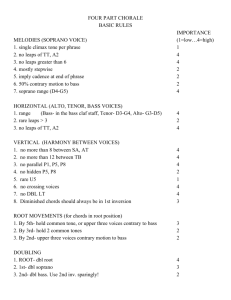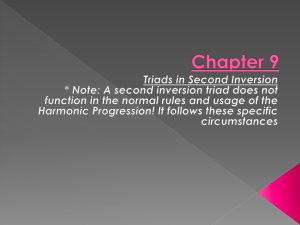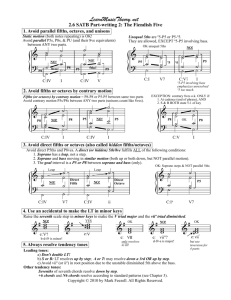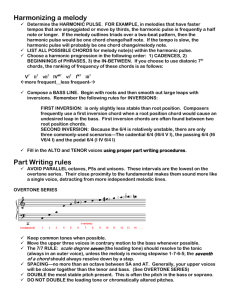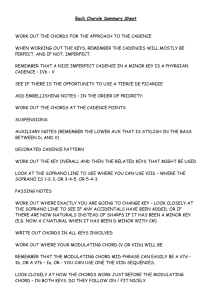Partwriting in Four – Voice Texture Chapter 6 Vocal Ranges
advertisement
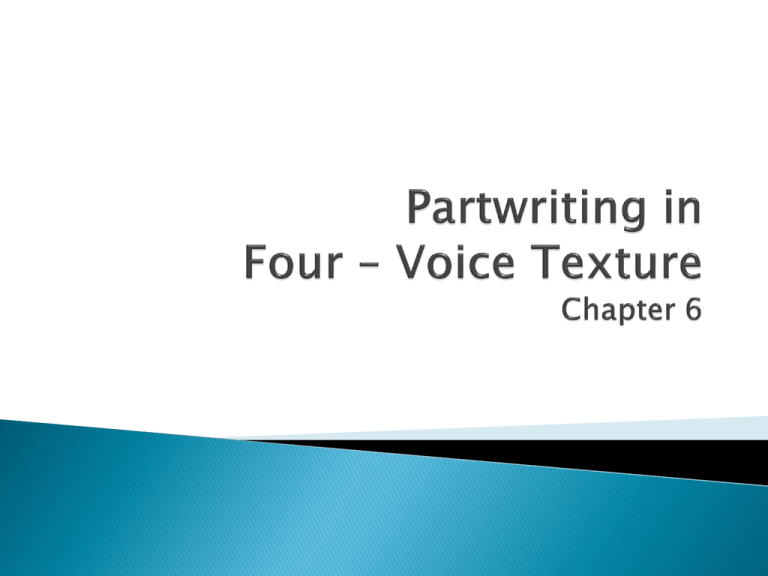
Each voice is set in a range that it can sing without strain. The blue circled note heads represent allowable extensions. Most voice parts should lie in the middle of each tessitura (range) “Rules” are based on ideal vertical sonority ◦ Doublings are influenced by the way voices move ◦ Most rules can be applied flexibly, with some exceptions and purposefully to create smoothness of line Root position chords – double the root Seventh chords (4 notes) – no doubling ◦ Sometimes root is doubled and 5th is omitted ◦ Never double the chordal seventh NEVER, NEVER double the leading tone ◦ Instant parallel octaves: ^7 must go to ^1 Vertical sonority is best with a complete triad 5th may be omitted of M or m root chord ◦ Triple the root, never double the 3rd Triads in inversion should be complete Root position seventh chords frequently omit the chordal 5th and double the root Seventh chord inversions should be complete Similar motion Parallel motion (5th and octaves) – big NO NO Oblique motion Contrary motion Melodic profile in relation to the other voices Each voice should be distinct in its profile – soprano has the greatest freedom Bass voice must provides the fundamental harmonic structure Be very careful with voice doublings – especially in inversions How individual voices move chord to chord ◦ There are guidelines; they aren’t written in stone The tricky bits where most errors occur: ◦ Melodic writing ◦ Melodic motion approaching & leaving perfect intervals ◦ Chordal spacing and structure ◦ Doubling of chord members Favor stepwise motion Occasional use of melodic leaps are OK ◦ 3rd, 4th, 5th, 6th ◦ Use octaves less often ◦ Change direction after big leaps (5th or greater) Go diatonic! Leave out diminished & augmented Stable tonality and clear cadence points Reiterated rhythmic/pitch patterns Favor stepwise motion over leaps ◦ Anything over a P5 should be avoided; exceptions are possible in the bass Avoid augmented intervals Diminished intervals are ok – they will occur in descending motion to the leading tone, which will resolve upward by semitone to tonic Consecutive leaps should be avoided unless the outline a triad, they should be balanced by stepwise motion before and after the leaps Leave any common tones between two chords in the same voice(s), and move the other voices to the nearest possible chord members of the second chord. Imperfect consonants (3rd & 6th) can be approached and left by similar, contrary or parallel motion Perfect intervals are a bit trickier… sigh Parallel unisons & octaves are forbidden ◦ Octaves that remain stationary are not parallel Parallel Perfect 5th - FORBIDDEN ◦ Similar motion between soprano and bass can promote parallel 5th; inner voices must leap by contrary motion No restrictions on Parallel Perfect 4th ◦ Frequently occur in progressions of successive first-inversion triads Contrary octaves or 5ths are regarded as parallels and should avoided Unequal 5ths ◦ P5 moves stepwise to a diminished 5th ◦ Diminished 5th moves stepwise to a P5 Avoid between soprano and bass on a change of harmony May occur moving by step between adjacent upper voices or outer voices on same harmony Direct octaves or 5ths ◦ Occur when two voices approach an octave or P5 by similar motion Avoid direct 8ves or 5th if the top voice moves by step Usually found in the outer voices (sop & bass) at cadence points, melodic nature of some cadences make them unavoidable Intervals larger than an octave should not occur between adjacent upper voice parts ◦ They are appropriate between tenor and bass Voice crossings are generally always avoided Voice overlaps occur when one voice moves higher or lower than the preceding note of the adjacent voice (usually between tenor and bass) – try to avoid them; they aren’t fatal. NEVER double the leading tone ^7 in Major and #6 and #7 in minor ◦ They resolve by step and have a strong tendency to create parallel octaves or 5th Avoid doubling altered notes 1. Utilize common voices and small motions 2. Conjunct motion is best; avoid large leaps 3. No augmented intervals; use diminished ones correctly 4. Never move all 4 voices in the same direction 5. Avoid // or contrary unisons, octaves, and Perfect 5th 6. Avoid intervals larger than an octave in S,A, & T 7. Avoid voice crossings and overlapping tones 8. Avoid doubling tendency tones and altered scale degrees
